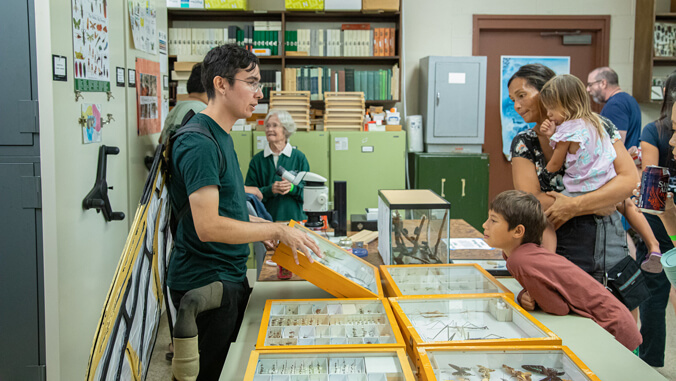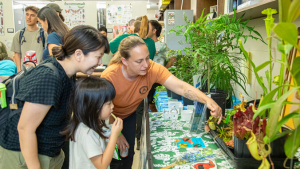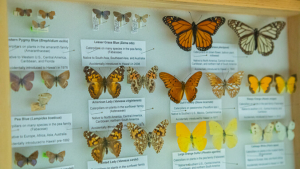
The University of Hawaiʻi Insect Museum at Gilmore Hall came alive with curiosity and exploration in celebration of Darwin Day 2025, a global celebration of science, discovery and evolutionary biology. Held every year on February 12, UH Mānoa’s event featured interactive exhibits and an adventurous insect-tasting session.

Nomi Ruiz, a team member of the UH Mānoa College of Tropical Agriculture and Human Resilience (CTAHR), examined an assortment of insect snacks at the museum before cautiously biting into a dark chocolate-coated cricket. She eyed a tray of chocolate chip cookies made with cricket flour, but decided she had enough six-legged treats for the day. Her food adventure set the tone for the event, which honored Charles Darwin and his groundbreaking contributions to the study of life sciences and natural selection.
“Darwin fundamentally reshaped how we view the natural world,” said Dan Rubinoff, director of the UH Insect Museum and professor at the Department of Plant and Environmental Protection Sciences. “This international event gives us a chance to celebrate those ideas and their relevance today.”
Rubinoff explained how the museum, which is part of the UH Mānoa College of Tropical Agriculture and Human Resilience, highlights Darwin’s legacy of evolution and understanding how life on Earth is shaped by our environment.
“That’s important not just for itself, but also for agriculture and conservation, because we have invasive species that come in and replace the native species,” Rubinoff said.
Darwin Day in Hawaiʻi

Spencer Pote, a PhD student at UH Mānoa, emphasized the importance of celebrating Darwin Day in the islands.
“The islands act almost like a conveyor belt of evolution, with species diversifying in ways we don’t see anywhere else,” Pote said. ”Darwin Day lets us share these incredible stories of natural diversity with the community.”
Galápagos finches, rare caterpillars
The museum buzzed with activity as visitors explored a diverse array of exhibits from UH Mānoa’s research labs. Displays featured ocean creatures from Kewalo Marine Lab and mantis shrimp from the Porter Vision Lab. A collection of Galápagos finches and snails from Bishop Museum’s Malacology Research Center were also on display. One of the most fascinating exhibits at the event showcased rare native species such as Hawaiʻi’s carnivorous caterpillars alongside invasive insects.
“We have over half a million specimens,” Rubinoff said. “Many of them date back to 1908, including species now extinct, making this collection invaluable for research and education.”
KTUH radio host Alex Sosa reflected on his first Darwin Day experience.
“It’s been amazing to learn so much—from upside-down jellyfish to carnivorous plants. Honestly, I love seeing science come alive in such a fun, interactive way.”

